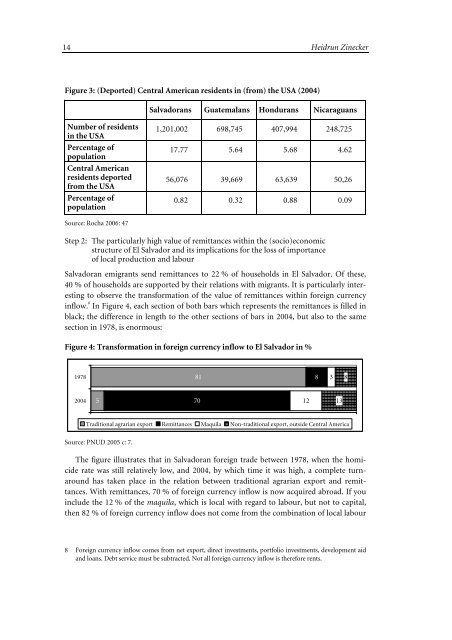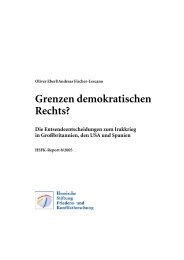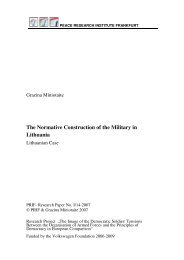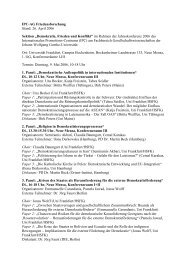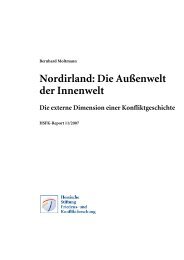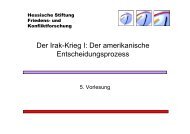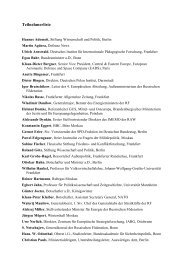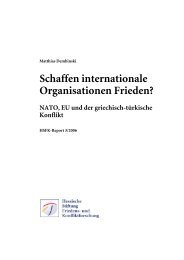From Exodus to Exitus Causes of post-war violence in El ... - eDoc
From Exodus to Exitus Causes of post-war violence in El ... - eDoc
From Exodus to Exitus Causes of post-war violence in El ... - eDoc
You also want an ePaper? Increase the reach of your titles
YUMPU automatically turns print PDFs into web optimized ePapers that Google loves.
14 Heidrun Z<strong>in</strong>ecker<br />
Figure 3: (Deported) Central American residents <strong>in</strong> (from) the USA (2004)<br />
Number <strong>of</strong> residents<br />
<strong>in</strong> the USA<br />
Percentage <strong>of</strong><br />
population<br />
Central American<br />
residents deported<br />
from the USA<br />
Percentage <strong>of</strong><br />
population<br />
Source: Rocha 2006: 47<br />
Salvadorans Guatemalans Hondurans Nicaraguans<br />
1,201,002 698,745 407,994 248,725<br />
17.77 5.64 5.68 4.62<br />
56,076 39,669 63,639 50,26<br />
0.82 0.32 0.88 0.09<br />
Step 2: The particularly high value <strong>of</strong> remittances with<strong>in</strong> the (socio)economic<br />
structure <strong>of</strong> <strong>El</strong> Salvador and its implications for the loss <strong>of</strong> importance<br />
<strong>of</strong> local production and labour<br />
Salvadoran emigrants send remittances <strong>to</strong> 22 % <strong>of</strong> households <strong>in</strong> <strong>El</strong> Salvador. Of these,<br />
40 % <strong>of</strong> households are supported by their relations with migrants. It is particularly <strong>in</strong>terest<strong>in</strong>g<br />
<strong>to</strong> observe the transformation <strong>of</strong> the value <strong>of</strong> remittances with<strong>in</strong> foreign currency<br />
<strong>in</strong>flow. 8 In Figure 4, each section <strong>of</strong> both bars which represents the remittances is filled <strong>in</strong><br />
black; the difference <strong>in</strong> length <strong>to</strong> the other sections <strong>of</strong> bars <strong>in</strong> 2004, but also <strong>to</strong> the same<br />
section <strong>in</strong> 1978, is enormous:<br />
Figure 4: Transformation <strong>in</strong> foreign currency <strong>in</strong>flow <strong>to</strong> <strong>El</strong> Salvador <strong>in</strong> %<br />
1978<br />
2004<br />
5<br />
81<br />
70<br />
Traditional agrarian export Remittances Maquila Non-traditional export, outside Central America<br />
Source: PNUD 2005 c: 7.<br />
The figure illustrates that <strong>in</strong> Salvadoran foreign trade between 1978, when the homicide<br />
rate was still relatively low, and 2004, by which time it was high, a complete turnaround<br />
has taken place <strong>in</strong> the relation between traditional agrarian export and remittances.<br />
With remittances, 70 % <strong>of</strong> foreign currency <strong>in</strong>flow is now acquired abroad. If you<br />
<strong>in</strong>clude the 12 % <strong>of</strong> the maquila, which is local with regard <strong>to</strong> labour, but not <strong>to</strong> capital,<br />
then 82 % <strong>of</strong> foreign currency <strong>in</strong>flow does not come from the comb<strong>in</strong>ation <strong>of</strong> local labour<br />
8 Foreign currency <strong>in</strong>flow comes from net export, direct <strong>in</strong>vestments, portfolio <strong>in</strong>vestments, development aid<br />
and loans. Debt service must be subtracted. Not all foreign currency <strong>in</strong>flow is therefore rents.<br />
12<br />
8<br />
3<br />
13<br />
8


